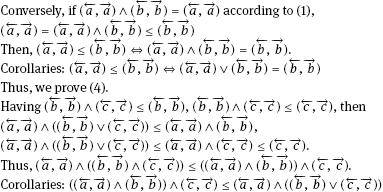
The prior of (5) is proved. The after is similar. Having
Having(←a,→a)≤(←a,→a),(←a,→a)≤(←a,→a)∨(←b,→b),then(←a,→a)≤(←a,→a)Λ((←a,→a)∨(←b,→b))≤(←a,→a);thus,(←a,→a)Λ((←a,→a)∨(←b,→b))=(←a,→a).Corollaries:(←a,→a)Λ((←a,→a)Λ(←b,→b))=(←a,→a)Having(a←,a→)≤(a←,a→),(a←,a→)≤(a←,a→)∨(b←,b→),then(a←,a→)≤(a←,a→)Λ((a←,a→)∨(b←,b→))≤(a←,a→);thus,(a←,a→)Λ((a←,a→)∨(b←,b→))=(a←,a→).Corollaries:(a←,a→)Λ((a←,a→)Λ(b←,b→))=(a←,a→)
Definition 8.22 We call partial order set ((←L,→L),≤)((L←,L→),≤) semilattice; when ∀(←α,→α),∀(α←,α→),(←β,→β)∈(←L,→L), we have (←α,→α)∨(←β,→β)∈(←L,→L)or (←L,→L)or(←α,→α)∧(←β,→β)∈(←L,→L).(β←,β→)∈(L←,L→), we have (α←,α→)∨(β←,β→)∈(L←,L→)or (L←,L→)or(α←,α→)∧(β←,β→)∈(L←,L→).
When ∀(←α,→α),(←β,→β)∈(←L,→L), we have(←α,→α)∨(←β,→β)∈(←L,→L),(←α,→α)∧∀(α←,α→),(β←,β→)∈(L←,L→), we have(α←,α→)∨(β←,β→)∈(L←,L→),(α←,α→)∧(←β,→β)∈(←L,→L),(β←,β→)∈(L←,L→), then we call the partial order set ((←L,→L),≤)((L←,L→),≤) as lattice.
Theorem 8.15 The necessary and sufficient conditions of set (←L,→L)(L←,L→) are a lattice:
(1)There are two operations ∨,∧, for any(←a,→a),(←b,→b)∈(←L,→L),∨,∧, for any(a←,a→),(b←,b→)∈(L←,L→), satisfying (←a,→a)∧(a←,a→)∧
(←b,→b)∈(←L,→L),(←a,→a)∨(←b,→b)∈(←L,→L).(b←,b→)∈(L←,L→),(a←,a→)∨(b←,b→)∈(L←,L→).
(2)(←a,→a)∨(←b,→b)=(←b,→b)∨(←a,→a),(←b,→b)∧(←a,→a)=(←a,→a)∧(←b,→b)(a←,a→)∨(b←,b→)=(b←,b→)∨(a←,a→),(b←,b→)∧(a←,a→)=(a←,a→)∧(b←,b→) (Commutative law)
(3)((←a,→a)∨(←b,→b))∨(←c,→c)=(←a,→a)∨((←b,→b)∨(←c,→c))((a←,a→)∨(b←,b→))∨(c←,c→)=(a←,a→)∨((b←,b→)∨(c←,c→))
(←a,→a)∧((←b,→b)∧(←c,→c))=((←a,→a)∧(←b,→b))∧(←c,→c)(a←,a→)∧((b←,b→)∧(c←,c→))=((a←,a→)∧(b←,b→))∧(c←,c→) (Associative law)
(4)(←a,→a)∧((←a,→a)∨(←b,→b))=(←a,→a)(a←,a→)∧((a←,a→)∨(b←,b→))=(a←,a→)
(←a,→a)∨((←a,→a)∧(←b,→b))=(←a,→a)(a←,a→)∨((a←,a→)∧(b←,b→))=(a←,a→) (Absorption law)
Proof: (sufficient)
(1): By known, we have ((←L,→L),≤)((L←,L→),≤) is lattice, according the definition of lattice. We prove (1).
(2): Assume (←a,→a)≤(←b,→b), then(←a,→a)∨(←b,→b)=(←b,→b)=(←b,→b)∨(←a,→a)=(←b,→b)(a←,a→)≤(b←,b→), then(a←,a→)∨(b←,b→)=(b←,b→)=(b←,b→)∨(a←,a→)=(b←,b→)(←a,→a)∨(←b,→b)=(←b,→b)∨(←a,→a);(a←,a→)∨(b←,b→)=(b←,b→)∨(a←,a→); in the same way, (←b,→b)∧(←a,→a)=(←a,→a)∧(b←,b→)∧(a←,a→)=(a←,a→)∧(←b,→b).(b←,b→).
When (←b,→b)≤(←a,→a),(b←,b→)≤(a←,a→), in the same way, we can prove (2).
(3)(4):Corollaries, according to the method in (2) (necessary):
(1)For any (←a,→a),(←b,→b)∈(←L,→L),(a←,a→),(b←,b→)∈(L←,L→), Then,
(←a,→a)∨(←b,→b)=(←b,→b)∨(←a,→a)⇒(←a,→a)=(←b,→b).(a←,a→)∨(b←,b→)=(b←,b→)∨(a←,a→)⇒(a←,a→)=(b←,b→).
According to (2), (←a,→a)∨(←b,→b)=(←b,→b)∨(←a,→a)⇒(←a,→a)=(←b,→b),(a←,a→)∨(b←,b→)=(b←,b→)∨(a←,a→)⇒(a←,a→)=(b←,b→),
Then, set ((←L,→L),≤)((L←,L→),≤) is antisymmetry.
(2)Assume (←a,→a)≤(←b,→b) and (←b,→b)≤(←a,→a). Then,(a←,a→)≤(b←,b→) and (b←,b→)≤(a←,a→). Then,
(←a,→a)≤(←b,→b)⇒(←a,→a)∨(←b,→b)=(←b,→b)(←b,→b)≤(←a,→a)⇒(←b,→b)∨(←a,→a)=(←a,→a)According to (2), (←a,→a)∨(←b,→b)=(←b,→b)∨(←a,→a)⇒(←a,→a)=(←b,→b).Then, set ((←L,→L),≤)is antisymmetry.(a←,a→)≤(b←,b→)⇒(a←,a→)∨(b←,b→)=(b←,b→)(b←,b→)≤(a←,a→)⇒(b←,b→)∨(a←,a→)=(a←,a→)According to (2), (a←,a→)∨(b←,b→)=(b←,b→)∨(a←,a→)⇒(a←,a→)=(b←,b→).Then, set ((L←,L→),≤)is antisymmetry.
(3)Assume (←a,→a)≤(←b,→b),(←b,→b)≤(←c,→c). Then,(a←,a→)≤(b←,b→),(b←,b→)≤(c←,c→). Then,
((←a,→a)∨(←b,→b))∨(←c,→c)=(←b,→b)∨(←c,→c)=(←c,→c)(←a,→a)∨((←b,→b)∨(←c,→c))=(←a,←a)∨(←c,→c)According to (3)((←a,→a)∨(←b,→b))∨(←c,→c)=(←a,→a)∨((←b,→b)∨(←c,→c))⇒(←a,→a)∨(←c,→c)=(←c,→c)⇒(←a,→a)≤(←c,→c)Namely (←a,→a)≤(b,b),(b,b)≤(←c,→c)⇒(←a,→a)≤(←c,→c),Then, set ((←L,→L),≤)is transitive.((a←,a→)∨(b←,b→))∨(c←,c→)=(b←,b→)∨(c←,c→)=(c←,c→)(a←,a→)∨((b←,b→)∨(c←,c→))=(a←,a←)∨(c←,c→)According to (3)((a←,a→)∨(b←,b→))∨(c←,c→)=(a←,a→)∨((b←,b→)∨(c←,c→))⇒(a←,a→)∨(c←,c→)=(c←,c→)⇒(a←,a→)≤(c←,c→)Namely (a←,a→)≤(b,b),(b,b)≤(c←,c→)⇒(a←,a→)≤(c←,c→),Then, set ((L←,L→),≤)is transitive.
(4)According to (1), for any (←a,→a),(←b,→b) ∈(←L,→L),(a←,a→),(b←,b→) ∈(L←,L→), there are (←a,→a)∧(←b,→b)∈(a←,a→)∧(b←,b→)∈(←L,→L),(←a,→a)∨(←b,→b)∈(←L,→L).(L←,L→),(a←,a→)∨(b←,b→)∈(L←,L→). Namely, the maximum lower bound and the minimum upper bound of any two elements are in the set. By (1)–(4), we can know that set (←L,→L)(L←,L→) is lattice.
According to the necessary and sufficient condition, the theorem holds.
(Prove up).
Theorem 8.16 Assume ((←L,→L),≤)((L←,L→),≤) is lattice, then we have the following properties:
(1)(←b,→b)≤(→c,←c)=(←a,←a)Λ(←b,→b)≤(←a,←a)Λ(→c,←c) (←b,→b)≤(→c,←c)=(←a,←a)∨(←b,→b)≤(←a,←a)∨(→c,←c)(2)(←a,→a)∨(←b,→b)Λ(→c,←c)≤((←a,→a)∨(←b,→b))Λ((←a,→a)∨(→c,←c)) (←a,→a)Λ(←b,→b)∨(→c,←c)≥((←a,→a)Λ(←b,→b))∨((←a,→a)Λ(→c,←c))(1)(b←,b→)≤(c→,c←)=(a←,a←)Λ(b←,b→)≤(a←,a←)Λ(c→,c←) (b←,b→)≤(c→,c←)=(a←,a←)∨(b←,b→)≤(a←,a←)∨(c→,c←)(2)(a←,a→)∨(b←,b→)Λ(c→,c←)≤((a←,a→)∨(b←,b→))Λ((a←,a→)∨(c→,c←)) (a←,a→)Λ(b←,b→)∨(c→,c←)≥((a←,a→)Λ(b←,b→))∨((a←,a→)Λ(c→,c←))
(3)(←a,→a)≤(→c,←c)⇔(←a,→a)∨((←b,→b)Λ(→c,←c))≤(←a,→a)∨((←b,→b)Λ(→c,←c)) ⇔(←a,→a)∨((←b,→b)Λ(→c,←c))≥(←a,→a)∨((←b,→b)Λ(→c,←c))(3)(a←,a→)≤(c→,c←)⇔(a←,a→)∨((b←,b→)Λ(c→,c←))≤(a←,a→)∨((b←,b→)Λ(c→,c←)) ⇔(a←,a→)∨((b←,b→)Λ(c→,c←))≥(a←,a→)∨((b←,b→)Λ(c→,c←))
Proof: (1) By Theorem 8.14: (←b,→b)≤(←c,→c)⇔(←b,→b)∧(←c,→c)=(←b,→b),(b←,b→)≤(c←,c→)⇔(b←,b→)∧(c←,c→)=(b←,b→), then ((←a,→a)∧(←b,→b))∧((←a,→a)∧(←c,→c))=((←a,→a)∧(←a,→a))∧((←b,→b)∧(←c,→c))=(←a,→a)∧(←b,→b), thus (←a,→a)∧(←b,→b)≤(←a,→a)∧(←c,→c).((a←,a→)∧(b←,b→))∧((a←,a→)∧(c←,c→))=((a←,a→)∧(a←,a→))∧((b←,b→)∧(c←,c→))=(a←,a→)∧(b←,b→), thus (a←,a→)∧(b←,b→)≤(a←,a→)∧(c←,c→).
Corollaries: ((←a,→a)∨(←b,→b))≤((←a,→a)∨(←c,→c))((a←,a→)∨(b←,b→))≤((a←,a→)∨(c←,c→))
(2)Hence, (←a,→a)≤((←a,→a)∨(←b,→b))∧((←a,→a)∨(←c,→c))and ((←b,→b)∧(←c,→c))≤((←a,→a)∨(←b,→b))∧((←a,→a)∨(←c,→c)); then the first part of (2) has been proved. In the same way, we can prove the second part.
(3)According to (←a,→a)≤(←c,→c)⇔(←a,→a)∨(←c,→c)=(←c,→c)⇔(←a,→a)∧(←c,→c)(←a,→a), namely (3).
[Prove up].
Definition 8.23 Lattice ((←L,→L),≤) is dense; when ∀(←α,→α),(←β,→β)∈(←L,→L) and (←α,→α)<(←β,→β), there exists (←γ,→γ)∈(←L,→L),let satisfy(←α,→α)<(←γ,→γ)<(←β,→β).

